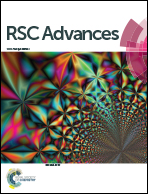Effects of functional groups on the tribological properties of hairy silica nanoparticles as an additive to polyalphaolefin†
Abstract
Hairy nanoparticles, which combine inorganic nanoparticles and organic polymers, have led to a variety of applications due to their special properties. In this paper, hairy silica nanoparticles (HSNs) with different functional groups and tribological properties were prepared and tested as additives to polyalphaolefin (PAO). Unmodified silica nanoparticles (USNs) were synthesized using the Stöber method and then modified by silanes with amino functional groups. The end groups of the silica nanoparticles were further functionalized by tethering different organic chains to the amino functionalized HSNs. HSNs-PAO lubricants were prepared by a four-step process and their tribological performances were tested using a four-ball tribometer. The coefficient of friction was recorded and the wear scar surfaces were examined by SEM and EDS. It was found that HSNs could form a stable homogenous solution when dispersed in PAO and exhibited good anti-wear and friction reduction properties. The NH2 terminated HSNs exhibited the best tribological performance but were more concentration sensitive than other types of HSNs due to the hydrogen bonds between amino groups. The long wear test results suggested that HSNs with polar functional groups accelerated the running-in process, which could be attributed to the adsorption of HSNs.



 Please wait while we load your content...
Please wait while we load your content...